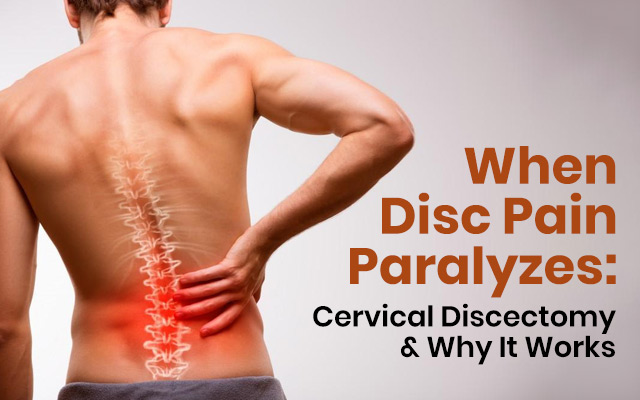Severe neck pain can disrupt your daily life and limit mobility. Consulting Dr. Rohit Mishra, a neurosurgeon in Kolkata, can help you explore treatment options. Here, we will discuss cervical discectomy surgery and how it relieves pain.
Understanding Cervical Disc Pain
Causes of Cervical Disc Herniation
Herniated discs occur when spinal discs bulge or rupture. Common causes include ageing, injury, repetitive strain, and poor posture. Genetics may also increase susceptibility.
Symptoms That Require Immediate Attention
Symptoms include numbness, tingling, weakness in the arms, and severe neck pain. Pain radiating to the shoulders or hands signals urgent evaluation.
How Disc Pain Affects Daily Life
Chronic pain can affect sleep, work, and physical activity. Untreated herniated discs may worsen over time, reducing quality of life.
Diagnosis of Cervical Disc Problems
Physical Examination and Clinical Tests
Doctors assess reflexes, muscle strength, and sensory responses to locate the affected nerve.
Imaging Techniques: MRI, CT, X-Ray
MRI is the gold standard for visualising disc herniation. CT and X-rays provide structural details.
Identifying Patients for Surgery
Doctors recommend surgery for patients with persistent pain, nerve compression, or functional limitation.
What Is a Cervical Discectomy?
Surgical Procedure Explained
Cervical discectomy surgery removes the damaged part of the disc. It helps relieve nerve pressure.
Types of Cervical Discectomy
Options include traditional open surgery and minimally invasive cervical discectomy. Choice depends on disc size, location, and patient health.
How the Surgery Relieves Pain
Removing the herniated disc reduces nerve compression. Herniated disc treatment restores mobility and offers spinal disc pain relief.
Minimally Invasive vs Traditional Surgery
Advantages of Minimally Invasive Techniques
Smaller incisions, reduced blood loss, faster recovery, and less postoperative pain are benefits.
Recovery Time and Complications
Recovery varies from a few weeks to months. Potential risks include infection, nerve injury, or incomplete pain relief.
Post-Surgery Recovery and Rehabilitation
Guidelines for Physical Therapy after Cervical Discectomy
Exercise programs strengthen neck muscles, improve flexibility, and prevent recurrence.
Lifestyle Adjustments for Spine Health
Maintain proper posture, avoid heavy lifting, and practice ergonomics at work and home.
Monitoring for Complications
Follow-up visits monitor wound healing, nerve function, and any signs of disc reherniation.
Risks and Benefits of Cervical Discectomy
Benefits include pain relief, improved mobility, and better quality of life. Risks involve surgical complications, infection, and rare nerve injury.
When to Consider Surgery vs Conservative Treatment
Surgery is indicated for persistent pain, neurological deficits, or failed conservative management. Non-surgical treatment includes medications, physical therapy, and lifestyle modifications.
Success Stories and Patient Outcomes
Many patients report improvement in pain and mobility after cervical spine surgery.
Regaining Mobility and Reducing Pain Safely
Cervical discectomy can provide lasting relief for herniated discs. Timely intervention prevents further nerve damage.
Consult Dr Rohit Mishra Today
Schedule a consultation with Dr Rohit Mishra, a neurosurgeon in Kolkata. He can offer expert evaluation and personalised treatment plans.
People Also Ask
- How long does recovery take after cervical discectomy surgery?
Recovery typically takes a few weeks, depending on the surgery type.
- Is minimally invasive cervical discectomy safe?
Yes, it reduces blood loss, pain, and speeds recovery.
- What are common cervical disc herniation symptoms?
Symptoms include neck pain, arm numbness, tingling, and muscle weakness.
- Can physical therapy prevent the need for neck disc surgery?
In some cases, targeted exercises and lifestyle changes reduce symptoms during neck disc surgery recovery.
- What are the risks and benefits of neck disc surgery?
Benefits include pain relief and improved mobility. Risks of the procedure are infection, nerve injury and reherniation.

